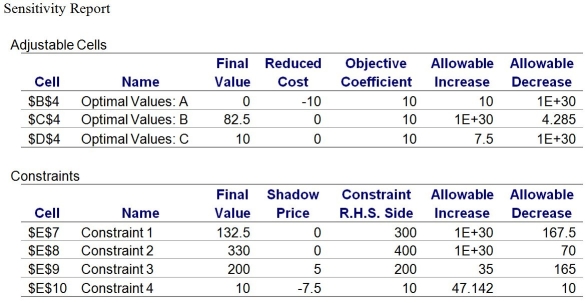Multiple Choice
Use this information,along with its associated Sensitivity Report,to answer the following questions.
A production manager wants to determine how many units of each product to produce weekly to maximize weekly profits.Production requirements for the products are shown in the following table.
Material 1 costs $7 a pound,material 2 costs $5 a pound,and labor costs $15 per hour.Product A sells for $101 a unit,product B sells for $67 a unit,and product C sells for $97.50 a unit.Each week there are 300 pounds of material 1;400 pounds of material 2;and 200 hours of labor.The output of product A should not be more than one-half of the total number of units produced.Moreover,there is a standing order of 10 units of product C each week.

-Suppose that the objective function coefficient for product C increases by $8.What impact will this have on the current values of the optimal solution?
A) No change.
B) Current solution will change.
C) Solution will become infeasible.
D) Solution will become unbounded.
E) Not enough information is provided.
Correct Answer:

Verified
Correct Answer:
Verified
Q20: When the Allowable Increase or Allowable Decrease
Q21: Impact of changes in RHS values of
Q22: A company can decide how many additional
Q23: Assume that the shadow price of a
Q24: The 100% Rule can be using to
Q26: A constraint has a slack of 5
Q27: The information provided in the Sensitivity Report
Q28: As long as the objective function coefficient
Q29: A constraint has a surplus of 10
Q30: Optimal solutions to linear programming problems are